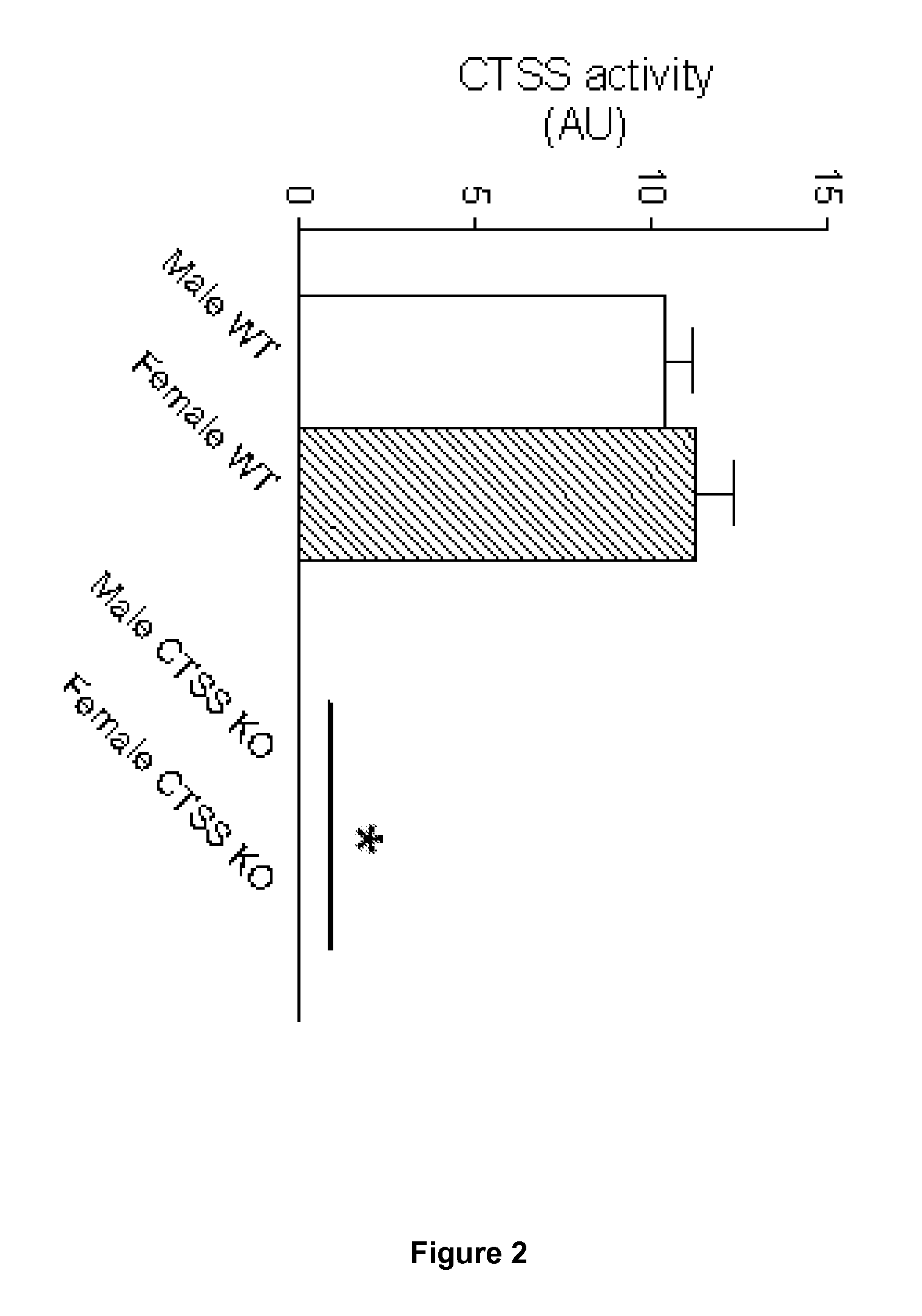Inhibitors of Cathepsin S for Prevention or Treatment of Obesity-Associated Disorders
a technology of cathepsin s and inhibitors, which is applied in the direction of biocide, drug composition, metabolic disorders, etc., can solve the problem of increasing the number of children and adolescents with type 2 diabetes at a worrying ra
- Summary
- Abstract
- Description
- Claims
- Application Information
AI Technical Summary
Benefits of technology
Problems solved by technology
Method used
Image
Examples
example 1
[0103]Material & Methods
[0104]1—Human Studies
[0105]The study enrolled a first population (P1) comprising 217 non diabetic obese subjects (BMI≧30 kg / m2) belonging to a larger population of individuals attending a metabolic ward at the Center for Detection and Prevention of Atherosclerosis (Marseille, France). The recruitment processes and study components have been previously described in (29). Local ethics committees approved the investigations and all subjects gave informed consent.
[0106]We also analyzed data obtained from a collaborative work of our team with Pr R. Rabasa-Lhoret, on a population of non-diabetic postmenopausal overweight and obese women. They were recruited from May 2003 to February 2006 for a weight-loss study by the Montreal Ottawa New Emerging Team (MONET) in the Department of Nutrition, Université de Montréal, Canada. Study inclusion and exclusion criteria were previously described in (30). The population (P2) included 137 women with mean age of 57.7±0.4 years ...
example 2
Changes in Energy Balance Predominantly Affect Cathepsin S in Adipose Tissue and in Circulation
[0132]Materials and Methods
[0133]Human participants. We recruited two clinical cohorts for this study. Firstly, from 2003 to 2006, 45 obese females were prospectively recruited from the gastric surgery program at the Department of Nutrition at Hôtel-Dieu Hospital (Paris, France). The women met the criteria for obesity surgery (i.e. BMI≧40 kg / m2 or ≧35 kg / m2 with at least one co-morbidity). They were excluded if they had evidence of inflammatory or infectious diseases, cancer, known alcohol consumption, as well as liver or kidney diseases. In this group, 7 women were classified as type 2 diabetic patients. Participants underwent a comprehensive clinical investigation before and 3 months after surgery, and were weight stable for 3 months before surgery. Seventeen normal weight and healthy female volunteers living in the same area as the obese subjects were recruited as a control group. This ...
example 3
Analyze of Gene Expression in the Liver of CTSS KO Mice
[0152]As a follow up of the observation that basal glucose turn-over rate is decreased in CTSS KO mice (FIG. 8), we have engaged an investigation of hepatic gene expression to estimate the activity of gluconeogenesis. This metabolic pathway controls hepatic glucose production. We expected that the absence of cathepsin S would reduced the level of expression of the genes involved in this pathway, thereby accounting for reduced hepatic glucose production in CTSS KO mice. Additionally, we determined the level of expression of selected enzymes and transcription factors involved in lipogenesis, a metabolic pathway that promotes fatty liver under a high fat nutritional challenge.
[0153]Methods
[0154]The liver of CTSS KO and age-matched wild-type mice was sampled in mice fed a chow or a high-fat diet for 8 weeks. RNA extraction was performed using the RNeasy RNA Mini Kit (Qiagen, Courtaboeuf, France). Total RNA concentration and quality ...
PUM
| Property | Measurement | Unit |
|---|---|---|
| energy | aaaaa | aaaaa |
| nutritional disorder | aaaaa | aaaaa |
| insulin resistance | aaaaa | aaaaa |
Abstract
Description
Claims
Application Information
 Login to View More
Login to View More - R&D
- Intellectual Property
- Life Sciences
- Materials
- Tech Scout
- Unparalleled Data Quality
- Higher Quality Content
- 60% Fewer Hallucinations
Browse by: Latest US Patents, China's latest patents, Technical Efficacy Thesaurus, Application Domain, Technology Topic, Popular Technical Reports.
© 2025 PatSnap. All rights reserved.Legal|Privacy policy|Modern Slavery Act Transparency Statement|Sitemap|About US| Contact US: help@patsnap.com



